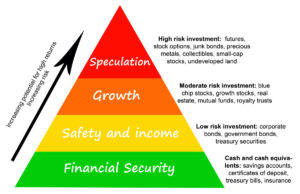Investing in stocks and bonds is a popular way to grow your wealth and achieve financial goals. But what exactly are stocks and bonds, and how do they work?
Stock and bond investing are two ways for individuals to invest their money in the financial markets.
Stock investing involves buying shares of ownership in a publicly traded company, with the goal of earning a return on the investment through the company’s growth and/or dividend payments.
Bond investing involves lending money to a company or government entity, with the goal of earning a fixed interest payment on the investment over a set period of time.
In this article, we will explore the basics of investing in stocks and bonds, including what they are, how they differ from each other, and the potential risks and rewards of investing in these securities.

What are stocks?
Stocks, also known as shares or equity, represent ownership in a company. When you purchase a stock, you become a shareholder and have a stake in the company’s ownership.
In return, the company may pay you a portion of its profits in the form of dividends or reinvest the profits back into the company to support growth.
Take the first step towards building your financial future with Acorns, the best investment app for beginners, and receive $5 to kickstart your investing journey.
How do stocks work?
The value of a stock can rise or fall depending on the performance of the company and other factors such as economic conditions and investor sentiment.
If the company performs well, investors may be willing to pay more for its stock, resulting in a higher stock price. Conversely, if the company performs poorly, investors may sell their shares, causing the stock price to drop.

Types of stocks
There are two main types of stocks: common stocks and preferred stocks.
Common stocks represent ownership in a company and typically offer voting rights at shareholder meetings.
Preferred stocks, on the other hand, usually do not offer voting rights but provide investors with a fixed dividend payment.
Investing in stocks
Investing in stocks can be a lucrative way to grow your wealth over time, but it also carries risks.
The stock market can be volatile, and the value of your investments can fluctuate based on a variety of factors.
Some investors may choose to invest in individual stocks, while others may opt for mutual funds or exchange-traded funds (ETFs) to diversify their portfolios.
What are bonds?
Bonds, also known as fixed-income securities, represent loans made to a company or government entity.
When you purchase a bond, you are essentially lending money to the issuer, who agrees to pay you back with interest over a set period of time.
How do bonds work?
Bonds are typically issued with a fixed interest rate, which means that the issuer pays the same rate of interest to investors for the duration of the bond’s term.
The value of a bond can also fluctuate based on changes in interest rates and other market conditions.
When interest rates rise, the value of existing bonds may decline, while bonds issued at higher rates may become more attractive to investors.

Types of bonds
There are several types of bonds, including corporate bonds, municipal bonds, and government bonds.
Corporate bonds are issued by companies, while municipal bonds are issued by local government entities such as cities or school districts.
Government bonds are issued by the federal government and are considered one of the safest types of investments.
Investing in bonds
Bonds can provide a steady stream of income for investors, making them a popular choice for those seeking to generate passive income.
However, like stocks, investing in bonds carries risks. Bonds can be affected by changes in interest rates, inflation, and other economic factors.
Investors may choose to invest in individual bonds or bond funds to diversify their portfolios.

Risks and Rewards of Investing in Stocks and Bonds
Investing in stocks and bonds can offer the potential for high returns, but it also carries risks.
Stocks are generally considered riskier than bonds, as the value of a stock can fluctuate more dramatically based on changes in the market or the company’s performance.
However, stocks also offer the potential for higher returns over the long term.
Bonds, on the other hand, are generally considered less risky than stocks but offer lower returns.
While the interest rate on a bond is fixed, the value of the bond can fluctuate based on changes in interest rates or other economic conditions.
What are Funds in Investing
A fund is a pool of money that is invested in various assets, such as stocks, bonds, or other securities, by a professional investment manager on behalf of a group of investors.
The investors in the fund own a portion of the underlying assets in proportion to their investment in the fund.
Investors can buy into a fund by purchasing shares or units of the fund, which represent their ownership in the underlying assets.
The value of the shares or units of the fund can go up or down depending on the performance of the underlying assets.
Funds are often designed to meet specific investment objectives, such as providing income, achieving long-term growth, or investing in a particular sector or geographic region.
There are many types of funds available, including mutual funds, exchange-traded funds (ETFs), index funds, hedge funds, and others.
Investing in a fund can be a convenient way to diversify a portfolio and access a range of different investments with potentially lower costs than buying individual securities.

However, it’s important to research and understand the risks and potential returns associated with a particular fund before investing.
There are various types of funds available for investing, including:
- Mutual Funds: A mutual fund pools money from many investors and invests in a diversified portfolio of stocks, bonds, or other securities.
- Exchange-Traded Funds (ETFs): ETFs are similar to mutual funds, but they trade like individual stocks on an exchange.
- Index Funds: Index funds are a type of mutual fund or ETF that tracks the performance of a specific market index, such as the S&P 500.
- Hedge Funds: Hedge funds are a type of investment fund that typically uses more advanced investment strategies and has higher fees than other types of funds.
- Money Market Funds: Money market funds invest in short-term, low-risk securities such as government bonds, certificates of deposit, and commercial paper.
- Bond Funds: Bond funds invest in a variety of bonds, including government, municipal, and corporate bonds.
- Sector Funds: Sector funds invest in companies within a specific industry or sector, such as technology or healthcare.
- Commodity Funds: Commodity funds invest in commodities such as gold, oil, or agricultural products.
- Real Estate Investment Trusts (REITs): REITs invest in real estate and allow investors to earn income through property rental or appreciation.
It’s important to research and understand the different types of funds available and the risks and rewards associated with each before investing.
Diversification
One way to mitigate risk when investing in stocks and bonds is through diversification.
Diversification means investing in a variety of stocks and bonds to reduce the impact of any one investment on your portfolio.
This can be achieved by investing in mutual funds or ETFs, which offer exposure to a broad range of stocks and bonds.

Importance of Diversification
Investors should consider diversification in their investment portfolio, as it can help reduce overall risk:
- Diversification helps reduce overall risk in an investment portfolio.
- By investing in a mix of different assets, sectors, and geographic regions, investors can minimize the impact of any one investment or sector on their portfolio’s performance.
- Diversification can help smooth out the ups and downs of a portfolio’s performance over time.
- Holding a diversified portfolio may allow investors to potentially earn higher returns with lower volatility.
- Diversification is an important risk management tool for achieving investment goals with greater certainty and less risk.
- The appropriate level and type of diversification will depend on an individual’s financial situation, goals, and risk tolerance.
Taxes
Another consideration when investing in stocks and bonds is taxes. The taxes you pay on your investments can impact your returns, so it’s important to understand the tax implications of your investments.

For example, capital gains taxes are applied to profits earned on the sale of investments, while dividends and interest income are taxed at different rates.
Timing
Timing is also an important factor to consider when investing in stocks and bonds.
Attempting to time the market, or buying and selling securities based on short-term market trends, can be risky and lead to poor investment decisions.
Instead, it’s generally recommended to adopt a long-term investment strategy and focus on investing in quality companies or bonds with a proven track record of success.
Time in the Market Vs Timing the Market
“Time in the market” and “timing the market” are two different investment strategies that can have very different outcomes.
“Time in The Market”
“Time in the market” refers to a long-term investment strategy where an investor buys and holds a diversified portfolio of stocks or other assets for an extended period of time, typically several years or more.
The idea is to ride out the short-term fluctuations in the market and benefit from the long-term growth potential of the investments.
This strategy can be beneficial because over long periods of time, the stock market tends to rise, and holding a diversified portfolio can help reduce the risks associated with individual stocks or sectors.
Investors who follow this strategy often aim to invest regularly and keep their investments for many years, if not decades.
“Timing the Market”
On the other hand, “timing the market” refers to an investment strategy where an investor tries to predict the short-term movements of the market and buy and sell assets accordingly.
This strategy typically involves trying to buy stocks or other assets when they are undervalued and sell them when they are overvalued.
While this strategy can potentially lead to higher returns, it is also much riskier, as it is difficult to predict short-term market movements with any degree of accuracy.
Attempting to time the market can also lead to missed opportunities and higher transaction costs.
Overall, “time in the market” is generally considered to be a more reliable and less risky investment strategy than “timing the market,” as it allows investors to benefit from the long-term growth potential of the stock market while avoiding the risks associated with short-term market movements.
If you’re looking for a beginner-friendly way to start investing, you should definitely check out the article on micro-investing!
It provides valuable insights on how you can begin investing in small amounts and gradually build your portfolio over time. Don’t miss out on this opportunity to kickstart your investment journey.

Investment Strategies
There are many different investment strategies for stocks and bonds, each with its own advantages and disadvantages. Here are some common strategies:
- Value investing: This strategy involves buying stocks that are undervalued based on fundamental analysis. Value investors believe that the market is sometimes inefficient and that they can find stocks that are trading below their intrinsic value.
- Growth investing: This strategy involves buying stocks that are expected to grow at a faster rate than the overall market. Growth investors are typically willing to pay a higher price-to-earnings ratio for these stocks because they believe in their long-term potential.
- Dividend investing: This strategy involves buying stocks that pay high dividends. Some investors use this strategy to generate regular income from their investments, while others reinvest the dividends to compound their returns over time.
- Dividend growth investing: This is a variation of the dividend investing strategy, where investors focus on buying stocks with a history of increasing their dividends over time. The idea is to invest in companies that are financially strong and committed to returning value to shareholders.
- Index investing: This strategy involves buying a diversified portfolio of stocks or bonds that track a particular index, such as the S&P 500 or the FTSE 100. Index investing is often used as a passive investment strategy, as it requires little research or active management.
- Momentum investing: This strategy involves buying stocks that have been performing well in the short term and selling those that have been performing poorly. The idea is to ride the momentum of the market and capture short-term gains.
- Contrarian investing: This strategy involves buying stocks that are out of favor with the market, often because of negative news or poor performance. Contrarian investors believe that the market overreacts to bad news and that these stocks are undervalued.
- Income investing: This strategy involves buying fixed-income securities, such as bonds, with the goal of generating regular income from interest payments. Income investors may also use dividend-paying stocks as part of their strategy.
These are just a few of the many investment strategies available to investors. Each strategy has its own unique benefits and risks, and the best strategy for an individual investor depends on their financial goals, risk tolerance, and investment time horizon.
I highly recommend signing up for M1 Finance if you want to take control of your financial future and experience the same success I have with my dividend growth portfolio.
Dollar Cost Averaging
Dollar-cost averaging is an investment strategy that involves investing a fixed amount of money at regular intervals over a period of time, usually into a diversified portfolio of stocks or funds.
This strategy aims to reduce the impact of market volatility on your investments by buying more shares when prices are low and fewer shares when prices are high.

For example, let’s say you want to invest $1000 in a mutual fund over the next 10 months.
Instead of investing the entire amount at once, you could invest $100 each month for 10 months.
By doing this, you’ll buy more shares when the price is low and fewer shares when the price is high.
Dollar-cost averaging can be a good strategy for long-term investors who want to reduce their risk and minimize the impact of market volatility on their portfolio.
However, it’s important to remember that this strategy does not guarantee a profit or protect against loss in a declining market.
Conclusion
Investing in stocks and bonds can be a valuable way to grow your wealth over time.
Stocks offer the potential for high returns but also carry greater risks, while bonds provide a more stable source of income but offer lower returns.

By diversifying your portfolio, understanding the tax implications of your investments, and focusing on a long-term investment strategy, you can maximize the potential rewards of investing in stocks and bonds while minimizing your risks.
